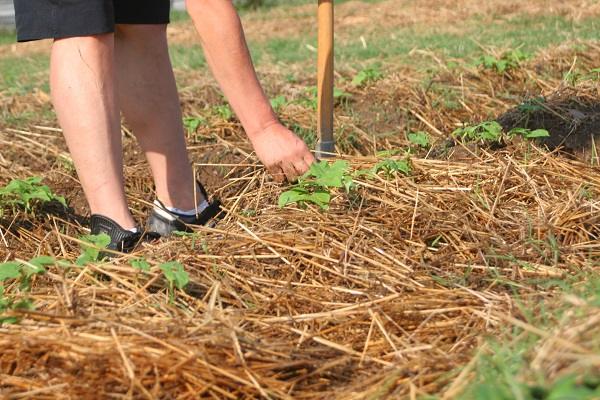
Applying mulch to your garden keeps soil temperature insulated from cold and hot weather, minimizes evaporation, and inhibits weed seed germination. A mulch is any material laid over the soil. Common mulches include crushed rock, bark, wood chips, grass clippings, straw, leaves, and compost.
Before selecting a mulch, you need to decide what you will be using it for — a utilitarian garden, a decorative garden or landscaping. Also, a couple of tips for all mulches. First, make sure and remove any weeds in the area to be mulched. Second, when applying mulch, leave a little room around the base of the plant or shrub.
Utilitarian Garden
For those of us living off the grid and striving for some level of self-sustainability, we are interested in mulch as an efficient tool to make our gardens more productive. Therefore, the criteria for selecting a mulch are availability and productivity of material. For example, if you make hay or straw as part of a homesteading operation, then that’s the material for you. Or perhaps you have trees that provide abundant leaves.
Mulch for the utilitarian garden is usually biodegradable so it has to be replaced periodically.
1. Straw
My favorite mulch is straw. It is readily available and gives my garden a natural look. Apply three to four inches of it around your plants.
Although straw is a favorite choice, it also has some disadvantages. Bugs and small critters seem attracted to it. I live in a hot and dry climate, so pests are not a big problem, but in cooler, wetter climates, you may have challenges with straw. Another disadvantage is the potential for seeds in straw. You can prevent this by purchasing certified seed-free straw, but if you harvest it yourself you may end up with weeds sprouting up—one of the reasons for using mulch in the first place. Finally, straw is more labor intensive to apply. It takes more work to separate it from the compacted bales and spread it around into a loosely compacted, level mulch.
A complete guide to using mulch in the garden.
2. Leaves
Leaves are another mulch possibility. The best thing about leaves is that they’re free and eventually add organic materials to the soil. However, you can’t just put a layer of dead leaves around your plants because they’re likely to blow away; and if they get wet they may decay anaerobically and form a dense material resulting in a thick mat that prevents water from reaching the soil. Instead, shred the leaves first. If you don’t have a shredder, partially compost the leaves before using. Another concern with leaves is weed seeds. If you get some dead grass in the leaves while collecting them, you may get some unwanted grass in your mulch.
3. Compost
Homemade compost is a valuable commodity. If you have extra left over after amending garden soil, then three or four inches of compost makes a great mulch.
4. Wood Chips
If you’re lucky enough to have a wood shredder, then consider using the wood chips for mulch. One study indicated that wood chips are great for water retention, temperature moderation and weed suppression. They are also longer lasting than straw, leaves or compost.
As with all mulches, there are also some potential concerns. However, with wood chips, these would not deter me from trying them. Some are concerned that wood chips may acidify the soil. While there is scant evidence of this, even if this happened, I wouldn’t worry because most common vegetables prefer a slightly acidic soil. Another concern about wood chips is that diseased trees may bring harmful fungi into the garden. While there is a debate about this, simply avoid the possibility by not using wood chips from diseased trees. Finally, there is some concern that decaying wood chips may remove needed nitrogen from the soil near the surface. To allay this, apply 1/4” of finely composted manure before placing the wood chips.
Overall, however, wood chips are a good candidate for mulching.
Decorative Gardens and Landscaping
Mulches for decorative gardens or for landscaping are chosen for aesthetic rather than utilitarian or self-sustainability reasons (except for water conservation, a concern in much of the country). Otherwise, the goal is beauty and permanence.
Before applying a mulch, remove all weeds and then cover with a heavy duty, contractor grade weed barrier.
5. Bark
Bark is relatively inexpensive and easy to apply. There are two choices: natural color and dyed bark. Although I find the natural shade of bark to be beautiful, dyed red and yellow barks are available. Some people enjoy these, especially when the color contrasts to the green and other colors of flowers in the garden or landscape. There are a couple disadvantages with bark. Some of it can blow away, and the dyed barks fade in color with time.
6. Pebbles or Crushed Rock
Rock is the ultimate mulch for a permanent solution. It also provides a complementary color to the dark green and other colors of lush foliage in a decorative garden. It is, however, relatively expensive and labor intensive to apply.
Conclusion
Mulch is a must for those living off the grid and growing food. It also conserves water, something everyone should be concerned about. Finally, it provides an aesthetic touch to decorative gardens or landscapes.
Sign up for Off The Grid News’ weekly email and stay informed about the issues important to you










